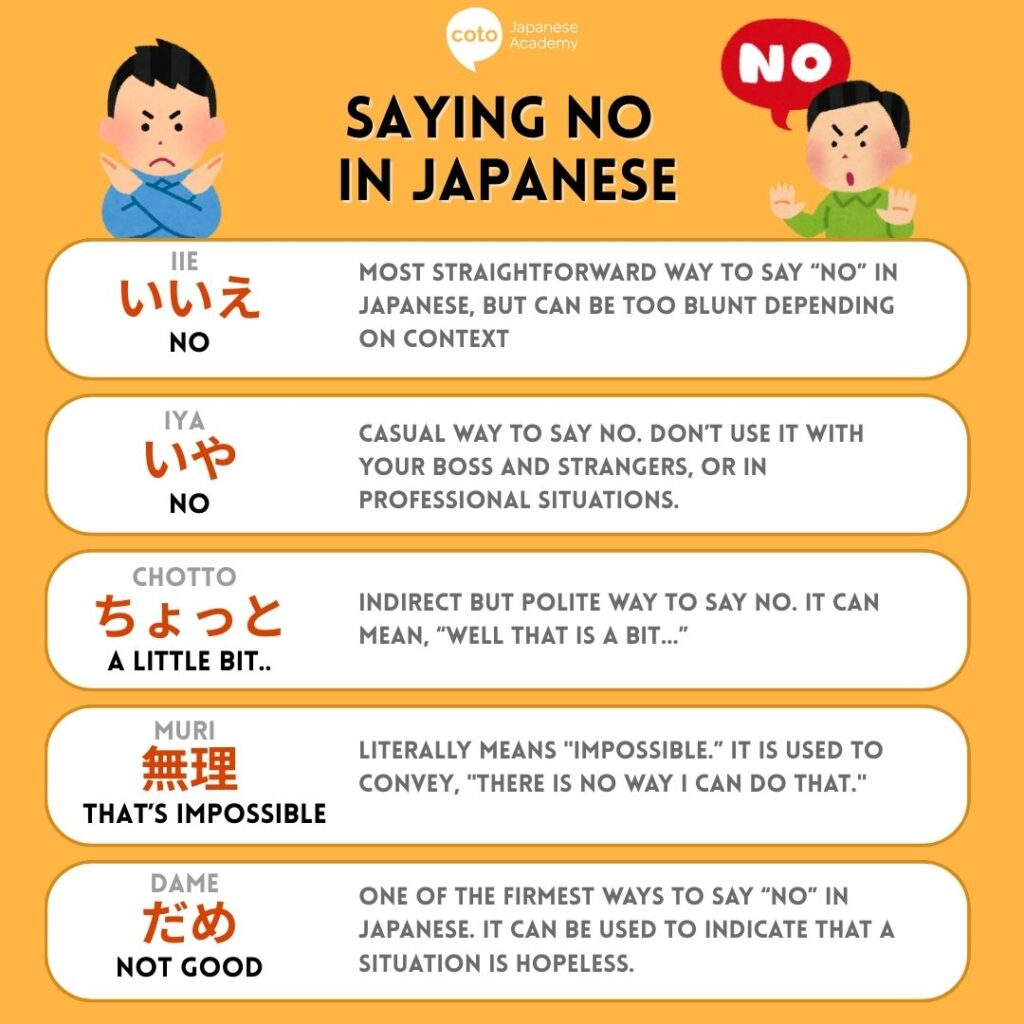The easiest way to say “no” in Japanese is by saying “いいえ (iie).” But did you know that it is not always that simple? Japanese people will rarely give a direct “no” as an answer, preferring instead to communicate indirectly a message that conveys so.
Japanese culture and the language itself have developed to prioritize politeness as a way to maintain peace and cooperation. Because of this, saying “no” directly can feel too harsh or disruptive in a society that highly values harmony. That’s why Japanese speakers usually choose their words very carefully, especially in business or formal situations.
So, what are the different ways you can say “no” in Japanese? How do you decline an invitation or a favor without offending your Japanese peers? In this article, we will go over some unique ways to turn something into Japanese. Let’s continue reading to find out!
Basic ways to say no in Japanese

The exact word and textbook translation for no in Japanese is “いいえ (iie).” In more casual settings, you might also say “ううん (uun)”. Let’s check them out in more detail.
1. いいえ (Iie)
The first and most straightforward way to say “no” in Japanese, which you’ll often see in textbooks, is いいえ (iie). It consists of a long “i” vowel, pronounced “ee” (like in tree), followed by “eh.”
However, textbooks don’t usually mention that iie can sometimes sound too blunt or harsh in real-life situations. While it’s common in forms or situations that require a clear “yes” or “no” — はい (hai) or いいえ (iie) — using iie in conversation can feel like a strong, outright rejection.
To soften your response, Japanese speakers often use いや (iya) in casual situations or いえ (ie) for a shorter, slightly more formal alternative when saying “no.” This brings us to our next topic!
2. いや (Iya)
いや (iya) is a casual way to say “no” or “I don’t want to” in Japanese. It’s less formal than いいえ (iie) and has a softer, more natural tone in everyday conversation. Unlike iie, which can feel like a blunt rejection, iya often expresses personal feelings or reluctance rather than an outright refusal.
There is a catch, though: iya is commonly used with people you are familiar with. We recommend avoiding using it with bosses, strangers, or in polite situations.
In any case, let’s take a look at an example of rejecting an offer using iya.
これ食べる?
Kore taberu?
Do you want to eat this?
いや、大丈夫。
Iya, daijoubu.
No, I’m fine.
3. ううん (Uun)
ううん (uun) is an informal, casual way to say “no” in Japanese. It is equivalent to “nah” or “nope” in English. To pronounce it, say it like oo-n, with a short pause between the vowels.
Despite being a casual way to say “no” in Japanese, ううん (uun) is often delivered with a friendly, soft intonation, making it a gentle refusal rather than a harsh rejection.
これ欲しい?
Kore hoshii?
Do you want this?ううん、いらない。
Uun, iranai.
No, I don’t need it.
Be careful not to confuse ううん (uun), a casual way to say “no,” with the “yes” version, うん (un). The latter is a shorter, more affirmative sound, often accompanied by nodding or other body language to show agreement.
4. ちょっと (Chotto)
Now we’re getting to ways of saying “no” indirectly. The first example is ちょっと (chotto), which literally means “a little” or “a little while.” You’ve probably heard it in the phrase ちょっと待って (chotto matte), meaning “please wait a moment.”
When used to decline something, chotto is often a shortened way of saying something like “it’s a little difficult” or “I’m a little too busy.” You can either leave it at just chotto, or add your own excuse.
The beauty of this approach is that, because Japanese people are accustomed to indirect communication, they can usually read between the lines and understand that you are politely declining. This is best used in casual situations with friends or family. Just remember: when someone says chotto to you, it’s also your cue to pick up on the polite refusal!
For example, they could say chotto, which conveys the difficulty of answering a request.
A: 明日一緒に飲みませんか?
Why don’t we drink together tomorrow?
Ashita, isshyo ni nomimasen ka?
B: ごめんなさい、明日はちょっと用事があって・・・
I am sorry, tomorrow. I have some errands…
Gomennasai, ashita wa chotto youji ga atte…
Perhaps the best way to interpret no in Japanese is to understand the different levels. We have divided them into four groups, starting from definite expressions to the grey and ambiguous expressions that you have to read between the lines.
How to say no in Japanese around friends & colleagues

There are three expressions typically used by friends and close colleagues when it comes to expressing refusal: むり, ダメ, and できない. These are ideal for more casual situations.
1. 無理 (muri)
Translation: Impossible
The word むり (muri) literally means “impossible.” It’s a way to say “no” by emphasizing that something can’t be done, like saying, “There is no way I can do that.”
There is a hint of sarcasm when using 無理 (muri), since it’s technically a hyperbole. Overusing it can make you sound negative or defeatist, so it’s best reserved for situations where refusal is truly unavoidable.
For example, if your friend asks if you can get to their house in 5 minutes but they live an hour away, you can say むり (muri).
2. ダメ (dame)
Translation: Not good
ダメ is usually translated into English as “no good”, “not allowed”, or “cannot”. Unlike ちょっと (chotto), which softens a refusal, だめ (dame) does the opposite: it is one of the firmest ways to say “no” in Japanese. It can be used to indicate that a situation is hopeless, that something is broken, or to tell someone that they shouldn’t do something.
A: あなたの部屋(へや)にたべてもいいですか?
Anatono heya ni tabetemo iidesuka?
Is it okay if I eat in your room?
B: だめです。
Dame desu.
No, you may not.
3. できない (dekinai)
Translation: Cannot
できない is less definite. できない emphasizes your personal inability rather than the impossibility of the situation itself. In other words, it expresses the speaker’s regret that the circumstances would not allow acting in accordance with one’s request. Always keep in mind, these expressions are rarely, if ever, heard as a response to a request in business-related situations.
The nuance of using できない (dekinai) is neutral and factual. Still, it can sound firm depending on the context.
明日手伝える?
Ashita tetsudaeru?
Can you help tomorrow?
ごめん、できない。
Gomen, dekinai.
Sorry, I can’t do it.
How to say no in Japanese in a business context

Saying “no” in Japanese when you are speaking with a client or company partner is even trickier. Professionals use softer, more tactful ways to decline requests, turn down proposals, or express limitations without offending colleagues or clients. In general, people can use these three expressions:
1. 厳しい (kibishii) & 難しい (Muzukashii)
Translation: Strict and difficult
Words like 厳しい (kibishii) or 難しい (muzukashii) are used to softly communicate refusal or difficulty. These terms imply that a request is challenging or difficult to fulfill, without outright rejecting it.
厳しい (kibishii) is often used to indicate that meeting a request would be difficult due to rules, standards, or constraints. 難しい (muzukashii), on the other hand, suggests that completing the task or agreeing to the request is complicated or challenging.
今の状況では、対応が難しいです。
Ima no joukyou dewa, taiou ga muzukashii desu.
Given the current situation, it’s difficult to accommodate.
2. 大変 (Taihen)
Translation: Tough, difficult, hard
たいへん (taihen), on the other hand, refers to a suggestion or request that is not easy because of a situation’s complexity. The word has a similar meaning to むずかしい (muzukashii), but is often used for situations or experiences rather than just problems.
The term たいへん can be subjective and creates ambiguity amongst the parties involved in various business relations.
Speaking Japanese in a formal capacity can seem overwhelming and full of nuances to be aware of. So, read our Introduction to Japanese Keigo to overcome the fear of speaking out of turn in delicate situations.
3. 遠慮する (Enryo suru)
遠慮する literally means “to refrain” or “to hold back,” and in business Japanese, it’s a polite way to decline an offer, invitation, or request without directly saying no.
今回は遠慮させていただきます。
Konkai wa enryo sasete itadakimasu.
I will respectfully decline this time.
Other ways to indirectly say no in Japanese
Other words tend to dwell in the grey areas of meaning and interpretation. Even native Japanese speakers could misinterpret the signals these words are meant to express. But it’s possible the ambiguity is intentional to avoid commitment or disrupting harmony when multiple parties are involved in the decision-making.
1. 微妙 (Bimiyoe)
Translation: Subtle, delicate, tricky
びみょう expresses a borderline scenario where neither party can express certainty of what will play out. Despite the underlying uncertainty hinted at in びみょう, more often than not, the speaker means to decline.
2. 結構です (Kekkou)
Translation: Enough
The Japanese expression けっこうです may be the greyest of these expressions. The term can have completely opposite meanings, such as an affirmative “ok” or a negative “no thank you”.
Read More: Japanese Words with Multiple Meanings.
3. 忙しい (Isogashii)
Translation: Busy
Now, this brings us to いそがしい, typically used as an excuse to decline a request. Of course, it is a tactical way to say no in Japanese, and you can use it even though you are not actually busy! People usually take it as an immediate hint that you can’t go to an invitation. If you got this reply from your Japanese peers, and don’t bother asking to reschedule despite!
明日、公園行くか?
Ashita, kouen iku ka?
Tomorrow, do you want to go to the park?
ごもえん、明日は少し忙しくて…
Sumimasen, ashita wa sukoshi isogashikute..
Sorry, tomorrow I am a bit busy..
4. 大丈夫 (Daijoubu)
大丈夫 (daijoubu) literally means “okay” or “all right,” but in Japanese, it can also be used to politely decline help, an offer, or a suggestion without directly saying “no.” Basically, you are saying that you can manage on your own or that the offer is not needed, making it a polite, soft refusal.
手伝いましょうか?
Tetsudai mashou ka?
Shall I help?
大丈夫です、ありがとうございます。
Daijoubu desu, arigatou gozaimasu.
I’m fine, thank you.
Showing uncertainty to indirectly refuse or decline something in Japanese
If you thought there weren’t enough ambiguous expressions for saying no in Japanese, there are a few more. However, these terms leave potential for an affirmative response. Initially, when someone uses these expressions, it may seem they are denying your request; however, they are actually expressing uncertainty about the current circumstances, which could change in the future
1. かもしれません / かもしれない / かも (Kamoshiremasen / kamoshirenai / kamo)
Translation: Maybe, might, possibly
かもしれません and all of its variations communicate a certain level of uncertainty, like saying “maybe” or “perhaps”. This expression is more of a clause that attaches to verbs or nouns. So, if you want to say “I probably can’t make it,” you would attach かもしれない to いけない by saying “いけないかもしれない”. This expresses a higher probability that you can’t make it, while being open to the possibility that you can.
In the video above, Yuka-sensei will introduce you to a more in-depth explanation of how to use かもしれない!
2. 多分 (tabun)
Translation: Maybe
たぶん is similar to かもしれない since it also conveys uncertainty. The difference here is that 多分 doesn’t attach to other words and can be used more flexibly. Below are some instances of how to use たぶん:
Using tabun when refusing
A: Can you make it? いけますか? ikemasuka?
B: Maybe, I cannot. 多分、いけません。tabun, ikemasen.
Using tabun when affirming
A: Is that a dog? 「それはいぬですか?」 sore wa inu desu ka
B: I think so. 「多分そうでしょう。」tabun soudeshou
3. 臨機応変に対応する (Rinkiouhen ni taiyou suru)
Translation: Let’s play it by ear
The expression, “りんきおうへんにたいおうする” is similar to the English expression: let’s play it by ear. This expression is often used to postpone difficult decisions at business meetings when the voting is not unanimous.
Go beyond saying no in Japanese and speak confidently with Coto Academy!
Why stop at just learning how to refuse something in Japanese? Keep improving your Japanese with fun, flexible lessons and expert guidance at Coto Academy. Our courses are designed for learners of all levels and provide practical, real-life Japanese that you can use immediately.
If you’re just starting your Japanese journey and want a comprehensive course that teaches everything from the basics, with easy-to-follow lessons, plenty of example sentences, and speaking practice, Coto Academy is here to help. Join our part-time or intensive courses, available in Tokyo, Yokohama, or online!
Start learning Japanese the smart way! Fill out the contact form below to get started and receive a free Japanese level check.
FAQ
What is the word for "no" in Japanese?
The direct translation for “no” in Japanese is いいえ(iie). But there are many ways one can say “no,” especially to be more polite in more formal or delicate situations.
What is a polite way to say "no" in Japanese?
There are many ways to say “no” politely in Japanese, such as simply saying “chotto,” which implies the request is a bit difficult to fulfill. In a situation when denying someone a kind offer, you could say “kekkou desu” or even “daijoubu desu”. In a more formal context, saying “kibishii” or “muzukashii” would be a polite way of saying “no”.
Do Japanese People Never Say "No"? Do they say something else instead?
Japanese people do say “no” but tend to do so in more indirect ways to avoid conflict. They don’t want to seem rude or outright decline someone. So, a few common phrases instead of a direct “no” include,
- 結構です (kekkou desu): It’s okay or I’m fine
- 厳しい (kibishii): tough/difficult situation
- 忙しい (isogashii): I’m busy
You might also be interested in:
